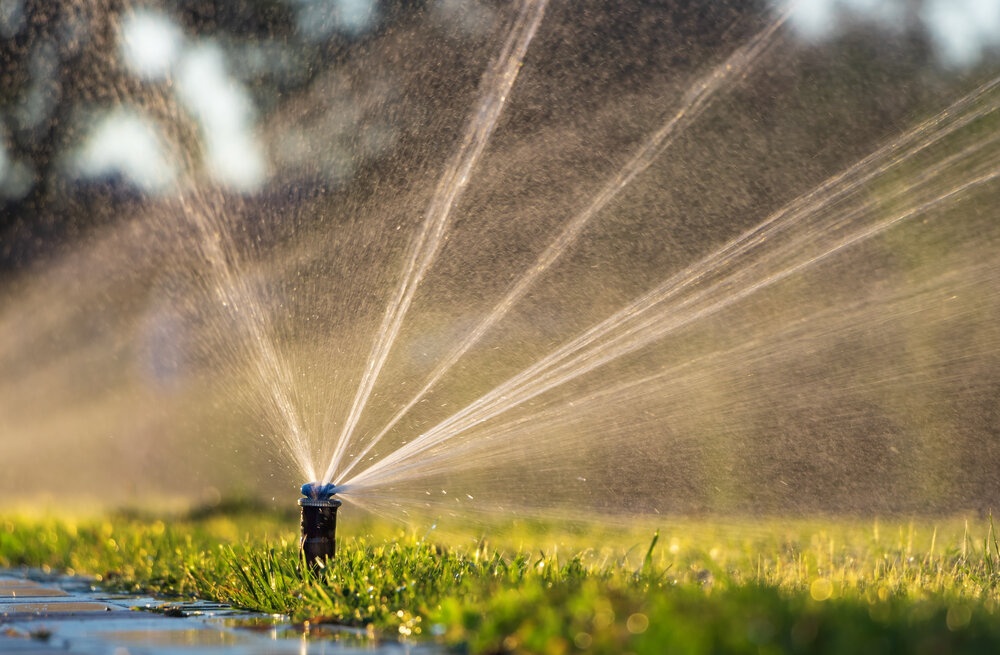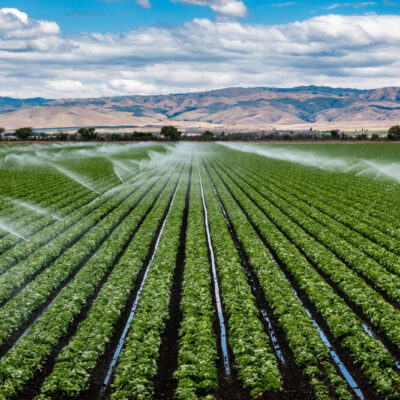If you need to locate underground irrigation lines it can often be very useful to do so without need ing to start digging the ground up.
Having a map or diagram to indicate where your sub-surface irrigation lines are will come in handy if you need to perform any maintenance or repairs to the system. It could also be useful if you are digging up part of the garden and want to avoid damaging any hidden lines.
How to Use a Diagram to Locate Underground Irrigation Lines
If you do have a diagram or map, the first thing to do is orientate it to the garden so you’re viewing it correctly in relation to the physical layout of the garden.
You then need to locate the position of the control box and the sprinkler heads. Obviously, the lines will run from head to head, but is there a pattern? Most sub-surface sprinkler systems are laid out geometrically in a rectangular and triangular pattern, as this helps to ensure uniform irrigation.
Of course, you might not have a diagram. But, if you hired a contractor to do the installation, contact them. They may well have a copy of the installation layout on their system.
If you did your own DIY installation and didn't think at the time to record the locations of the lines, you might rue the oversight.
Perhaps you inherited an existing sprinkler system when you bought the property? If this is the case and the previous owner didn’t leave a map or diagram behind, you could be stymied.
If you do find yourself in one of these situations without a map or diagram, all is not lost. You’ll find everything you need to know about locating buried irrigation lines without having to do any digging right here in this blog. Please read on.
Where and How to Start

Before you start worrying about a leak in your sprinkler system, if you’ve got pop-up sprinkler heads, check these first to make sure they’re not simply blocked with dirt. If they are, simply brush off the dirt, and if that cures the problem, all is well and good. If it doesn't, it means there is probably a leak somewhere along the underground lines, which you'll have to locate.
Before you begin, you need to be familiar with the components of a typical sprinkler system. They are:
- The control box.
- Solenoids and valves – (located underground, normally near the control box)
- A non-return valve.
- The sprinkler lines.
- The sprinkler heads.
Step by Step Instructions for Locating the Sprinkler Lines
Luckily, locating the line layout of your irrigation system isn’t rocket science. These are the steps to follow:
- Find the control box – Often found in a garage or basement. Once located, see where the wires exit.
- Follow the electrical wiring – Establish the entry point which takes the wiring underground.
- Locate the valve box – A little light excavation should locate the box. Once found, clean off any dirt and open it. If you have more than one irrigation circuit, each one will have its own valve box.
- Note in which direction the sprinkler line goes.
- Activate the system – Take note of which sprinkler pops up first.
The majority of sprinkler systems are laid out in a rectangular shape, with the pop-up heads installed on the long sides of the rectangle so they are facing each other.
The first pair of pop-up heads opposite each other will appear simultaneously, then the next pair, etc. With this shape installation, there is normally a single line running from the valve box. This goes into a T-shaped connector to divert the flow to the first pair of sprinkler heads.
If your system has PVC pipes, that might make it a little trickier to locate the problem
Using a Metal Detector

If you’re a detectorist (the official term for the many people who like to go out searching for hidden treasure or historical artefacts with a metal detector), you might be able to use your device to locate underground irrigation lines in your garden.
Most irrigation pipes these days are made from PVC, but if whoever installed the lines thought to install a metal tracer wire alongside or even inside the line, a metal detector would be able to locate and trace the wire. If a tracer wire hasn’t been installed but one end of the line is open, you might even be able to feed one through it.
Tracer wire is inexpensive, and you can buy it from any electrical store or even eBay. Make sure you lay it above the irrigation line just below the surface of the ground to make it easier to detect.
If tracer wire wasn’t installed, you will have to locate the valve box, and you can use a metal detector to do so.
As mentioned earlier, most sprinkler systems are rectangular. This is because the connectors are either straight inline or T-shaped. Once you uncover the valve box, you’ll be able to see in which direction the pipes go.
The next step is to dig along the line to expose the pipes. It does, of course, mean digging up the grass. The only way around this, is to use some sort of special device.
Other Ways of Locating Underground Pipes
Finding the exact location of underground PVC pipes without locating and uncovering the valve box is challenging. It is much more difficult than locating metal pipes or plastic pipes that don't have a metal tracer wire installed, as it comes down to two things. They are the skill and listening ability of the equipment user, and the conditions in which the equipment is used.
Using the best equipment you can get your hands on is important, as top-quality products provide you with more audio options, such as different microphones to collect feedback and different ground probes to insert into the ground and send out signals.
New acoustic PVC material detectors are becoming increasingly popular so these could be an option. These devices are not cheap to buy but could be considered to be of more interest as an investment to corporate bodies like golf courses, which might have a regular need and want to avoid having to dig up fairways and greens as much as they can.
Another technology available is that of ground penetrating radar. But this is not only quite an expensive piece of kit to buy or hire, but it also needs to be operated by a trained person for best results.
It’s worthwhile checking your local area to see if there are any contractors around that you can hire to do the location for you. It could be the cheapest option.
Locating and Fixing an Underground Leak
If you find muddy pools appearing regularly in your garden, you might have a leak in your sprinkler system. It doesn't just ruin the aesthetics; it also means your water bills could be higher. Alternatively, you might have dry patches on one side due to irrigation water not being able to get through to all the sprinkler heads.
Whatever materials the sprinkler lines are made from, you can locate a leak with accuracy using certain leak noise detectors, including:
- Leak noise locators
- Leak noise correlators
- An acoustic testing kit complete with water leak microphone and headset.
All of the above devices work based by detecting sound waves. They incorporate highly sensitive components known as transducers. These devices are able to tell the difference in the noise of the water by hearing the “hissing” sound that escaping water makes, thus pinpointing where the disruption is in the water flow. The most sensitive of the three are water leak correlators.
However, the downside to using these specialised detection tools is that they are technical pieces of equipment, and users require some basic training to interpret the readings they give.
They are also expensive pieces of kit, in general costing more than £2,000 each. While, as mentioned earlier, this could be affordable for corporate users who might have a regular use for them – like golf courses for example, they are far too expensive for the average home gardener.
Things to Bear in Mind When Installing New Sprinkler Lines

If you are thinking about installing a new sprinkler system, reading through the above will hopefully give you some food for thought.
Sprinkler pipes today are normally made from plastic or PVC, and you might, for example, not have thought about the need to trace the line layout in a few years’ time, or the problems a new property owner might face if you sell up and don’t have a map or diagram to pass on.
In this instance, installing metal tracing wire beside the lines offers the best chance of locating the lines using a metal detector, which can usually be hired from a local hire store, should the need arise.
Conclusion
Damage or problems affecting sprinkler systems can be caused by many things, including:
- The age of the sprinkler system.
- Tree roots.
- Very high temperatures.
Whatever the cause of the problem, you now know about several options regarding locating sub-surface sprinkler lines without going through the annoying and time-consuming process of digging blind. We hope we have been of help.

